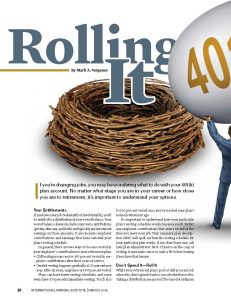AN EARLY OUT? NOT SO FAST.
How to evaluate an early retirement offer and see if it’s the right move for you.

In today’s corporate environment, cost cutting, restructuring, and downsizing are the norm, and many employers are offering their employees early retirement packages. But how do you know if the seemingly attractive offer you’ve received is a good one? There’s a simple answer: By evaluating it carefully to make sure the offer fits your needs.
What’s the Severance Package?
Most early retirement offers include a severance package that is based on your annual salary and years of service at the company. For example, your employer might offer you one or two weeks’ salary (or even a month’s salary) for each year of service. Make sure the severance package will be enough for you to make the transition to the next phase of your life. Also, make sure you understand the payout options available to you. You may be able to take a lump-sum severance payment and then invest the money to provide income or use it to meet large expenses. Or you may be able to take deferred payments during several years to spread out your tax bill on the money.
How Does this Affect Pension?
If your employer has a traditional pension plan, the retirement benefits you receive from the plan are based on your age, years of service, and annual salary. You typically must work until your company’s normal retirement age (usually 65) to receive the maximum benefits. This means you may receive smaller benefits if you accept an offer to retire early. The difference between this reduced pension and a full pension could be large, because pension benefits typically accrue faster as you near retirement. However, your employer may provide you with larger pension benefits until you can start collecting Social Security at age 62. Alternately, your employer might boost your pension benefits by adding years to your age, length of service, or both. These types of pension sweeteners are key features to look for in your employer’s offer, especially if a reduced pension won’t give you enough income.
What about Health Insurance?
Does your employer’s early retirement offer include medical coverage for you and your family? If not, look at your other health insurance options, such as COBRA, a private policy, or dependent coverage through your spouse’s employer-sponsored plan. Because your health care costs will probably increase as you age, an offer with no medical coverage may not be worth taking if these other options are unavailable or too expensive. Even if the offer does include medical coverage, make sure you understand and evaluate the coverage. Will you be covered for life or at least until you’re eligible for Medicare? Is the coverage adequate and affordable (some employers may cut benefits or raise premiums for early retirees)? If your employer’s coverage doesn’t meet your health insurance needs, you may be able to fill the gaps with other insurance.
What about Other Benefits?
Some early retirement offers include employer-sponsored life insurance. This can help meet your life insurance needs, and the coverage probably won’t cost you much (if anything). However, continued employer coverage is usually limited (for example, one year’s coverage equal to your annual salary) or may not be offered at all. This may not be a problem if you already have enough life insurance elsewhere or if you’re financially secure and don’t need life insurance. Otherwise, weigh your needs against the cost of buying an individual policy. You may also be able to convert some of your old employer coverage to an individual policy, though your premium will be higher than when you were employed.
In addition, a good early retirement offer may include other perks. Your employer may provide you and other early retirees with financial planning assistance. This can come in handy if you feel overwhelmed by all of the financial issues that early retirement brings. Your employer may also offer job placement assistance to help you find other employment. If you have company stock options, your employer may give you more time to exercise them. Other benefits, such as educational assistance, may also be available. Check with your employer to find out exactly what its offer includes.
Can You Afford It?
To decide if you should accept an early retirement offer, you can’t just look at the offer itself. You have to consider your total financial picture. Can you afford to retire early? Even if you can, will you still be able to reach all of your retirement goals? These are tough questions that a financial professional should help you sort out, but you can take some basic steps yourself.
Identify your sources of retirement income and the yearly amount you can expect from each source. Then, estimate your annual retirement expenses (don’t forget taxes and inflation), and make sure your income will be more than enough to meet them. You may find that you can accept your employer’s offer and likely still have the retirement lifestyle you want. But remember, these are only estimates. Build in a comfortable cushion in case your expenses increase, your income drops, or you live longer than expected.
If you don’t think you can afford early retirement, it may be better not to accept your employer’s offer. The longer you stay in the workforce, the shorter your retirement will be and the less money you’ll need to fund it. Working longer may also allow you to build larger savings in your IRAs, retirement plans, and investments. However, if you really want to retire early, making some smart choices may help you overcome the obstacles. Try to lower or eliminate some of your retirement expenses. Consider a more aggressive approach to investing. Take a part-time job for extra income. Finally, think about electing early Social Security benefits at age 62, but remember that your monthly benefit will be smaller if you do this.
Finding a New Job
You may find yourself having to accept an early retirement offer even though you can’t afford to retire. One way to make up for the difference between what you receive from your early retirement package and your old paycheck is to find a new job, but that doesn’t mean you have to abandon your former line of work for a new career. You can start by finding out if your former employer would hire you as a consultant. Or, you may find that you would like to turn what was once just a hobby into a second career. Then there is always the possibility of finding full- or part-time employment with a new company.
For the employee who has 20 years of service with the same company, the prospect of job hunting may be terrifying. If you have been out of the job market for a long time, you might not feel comfortable or have experience marketing yourself for a new job. Some companies provide career counseling to assist employees re-entering the workforce. If your company does not provide you with this service, you may want to look into corporate outplacement firms and nonprofit organizations in your area that deal with career transition.
Many early retirement offers contain noncompetition agreements or offer monetary inducements on the condition that you agree not to work for a competitor. However, you’ll generally be able to work for a new employer and still receive your pension and other retirement plan benefits.
What If You Say No?
If you refuse early retirement, you may continue to thrive with your employer. You could earn promotions and salary raises that boost your pension. You could receive a second early retirement offer that’s better than the first one. But you may not be so lucky. Consider whether your position could be eliminated down the road.
If the consequences of saying no are hard to predict, use your best judgment and seek professional advice. But don’t take too long. You may have only a short window of time, typically 60 to 90 days, to make your decision.
MARK A. VERGENES, is president of Financial Partners and chair of the Lancaster (Pa.) Parking Authority. He can be reached at mark@mirusfinancialpartners.com
TPP-2017-01-Early Out? Not so fast.


 By Scott A. Petri
By Scott A. Petri By Mark A. Vergenes
By Mark A. Vergenes By L. Dennis Burns, CAPP
By L. Dennis Burns, CAPP
